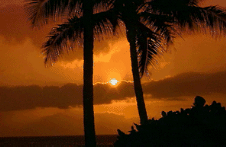Oahu: What To Know
However, by the time King Kamehameha I died in 1819, Hawaii's socioeconomic system was already undergoing dramatic changes. Many of the ancient customs of the traditional "kapu" system were overthrown, and the burgeoning whaling industry and the missionionary movement were beginning to alter the islands' former way of life.
Hawaii slowly became populated by mainlanders trying to make money off of the islands' natural riches. And as in many parts of the world, the indigenous traditions of the Hawaiian islands ultimately gave way to sometimes violent pressures from missionaries, to be replaced by Catholicism and Christian morality.
By the late 19th-century, the United States was actively involved in shaping the islands' politics. Although the majority of Hawaiians opposed annexation, President McKinley signed an annexation agreement on July 7, 1898. An important Allied naval base during World War II, Oahu's Pearl Harbor was the site of the Japanese 1941 bombing which ultimately lead to the U.S.'s involvement in the war. Hawaii was finally granted statehood on August 21, 1959.
Although contemporary culture in Hawaii is similar to that of the rest of the U.S., Hawaiians strive to preserve cultural traditions. Language and hula classes are common, and traditional arts and crafts thrive. The social tradition of giving flower necklaces, or leis, illuminates the richness of the Hawaiian culture. Different leis have different meanings. For example, tourists are given leis of plumeria, while a bride might wear a lei of pikake. There are special leis for hellos and good-byes, and each island has its own particular lei.
For dessert, try a local favorite, shave ice--it's like a snow cone but even better. Or, sink your teeth into some chocolate-covered macadamia nuts, available at nearly every drugstore, grocery store, and souvenir shop.
Hawaii International Jazz Festival

Location
The Hawaiian Islands are located just south of the Tropic of Cancer in the Pacific Ocean, 2,400 miles southwest of California. Oahu is situated to the southeast of Kauai and to the northwest of Molokai. Hawaii's capital, Honolulu, is located on Oahu. You can get to know the island by looking at a map.
Geology
The Hawaiian islands were all formed by volcanic activity on the ocean floor of the Pacific. Each island is essentially a mountainous volcano or group of volcanoes that has risen above the surface of the ocean and expelled lava to create land mass. Oahu is the third largest of the six major islands in the Hawaiian Island chain, and the second youngest.
History
Before annexation to the United States, Hawaii was once an independent kingdom. Each island was a separate domain until 1795, when the first King Kamehameha united all of Hawaii. The charismatic Kamehameha and a dynasty of his progeny ruled the islands for the next century.
Weather
The average annual temperature on Oahu is 80 degrees Fahrenheit, and nights get a bit cooler. Temperatures tend to be a few degrees higher during the summer, and a bit lower during winter. Oahu's east side is the wettest part of the island; the west, north, and south sides of the island are dryer and more sunny. While the average rainfall in Waikiki is only 25 inches, the upper Manoa Valley, north of Honolulu, averages 158 inches of rain per year. Check out Oahu's current weather forecast in order to better plan your trip.
When to Go
Any time is a good time to visit Oahu. While the island's primary tourist resorts stay full most of the year, accommodations are less expensive during off season, which is between April and mid-December.
People/Character
Over 875,000 people live on Oahu. People of Caucasian origin compose 24 percent of the population, while 21 percent are Japanese, 16 percent are Hawaiian and part-Hawaiian, and 39 percent are Filipino, Chinese, and other Asians.
Cuisine
Hawaii's sizable Asian influence is evidenced by much of the islands' cuisine. A typical "mixed plate" for lunch comes with rice and macaroni salad, as well as your choice of an Asian dish such as chicken teriyaki (Japanese), beef with oyster sauce (Chinese), or kalua pig (Hawaiian). Kalua pig, a favorite of luaus, is a suckling pig slow-cooked in an underground oven. Dried salted fish is also a favorite, as is poi, a stew made from the taro plant. Indigenous fruits such as star fruit and breadfruit are used in many traditional recipes.
Calendar of Events
Below you'll find a listing of the many events and activities on Oahu. For the latest goings-on in Oahu, refer to the Honolulu Star-Bulletin and the Pacific Business News.
Hula Bowl: The championship college football game is played at the Aloha Stadium.
Chinese New Year: A celebration is held in Honolulu's Chinatown with lion dances, drums, and firecrackers.
Buffalo Big Board Surfing Classic at Makaha Beach: This event is a test of skill and showmanship on old-style longboards
Buddha Day: Hawaii's Buddhist population is sizable, and this day is celebrated state-wide with pageants, dances, and flower festivals.
Lei Day by the Bay: Most Hawaiians wear leis on this day and lei-making competitions pay tribute to the ancient art.
King Kamehameha Day: In honor of the king who unified the islands, Hawaii celebrates a state holiday with colorful parades and other events.
Festival of the Pacific: A week-long celebration of Pacific Rim culture.
Slack-Key Guitar Festival: A free five-hour concert held at Ala Moana Beach Park.
Aloha Week: A statewide festival celebrating Hawaiian culture with parades, dances, canoe racing, and other traditional contests
Hawaii International Film Festival
© 1999 Travel with Aloha. All Rights Reserved.